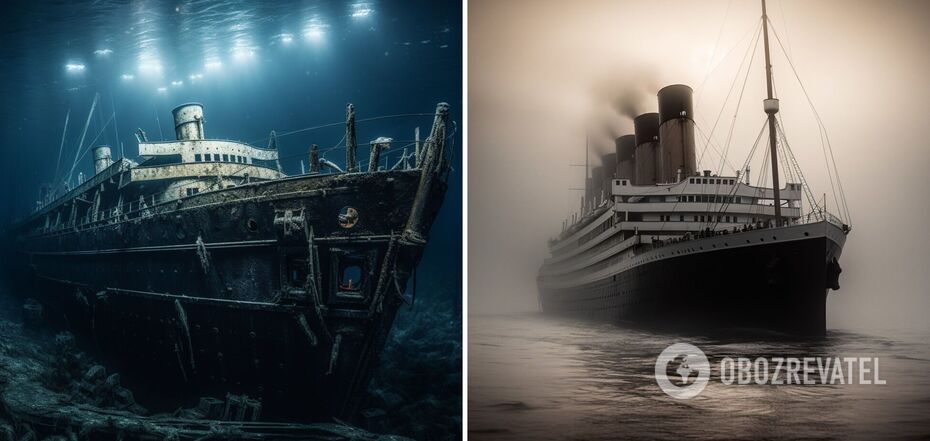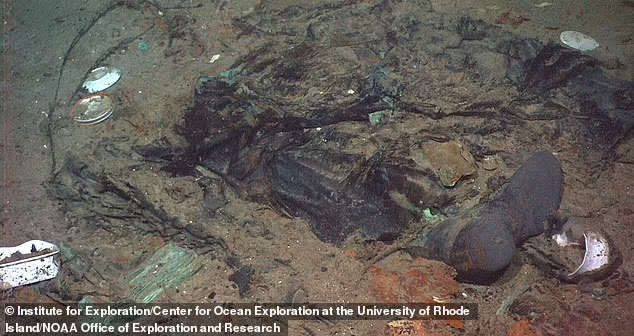Life
Most of Titanic passengers' bodies were never found: Strange photos shed light on mystery
The sinking of the ocean liner Titanic in April 1912 took the lives of more than 1,500 people. What makes the event even more tragic is that about 1,160 bodies were never recovered. And here are some photos indicating the likely fate of all those people.
According to the Mail Online, the pictures show shoes and champagne bottles belonging to the passengers of the ship. Journalists interviewed experts who shed light on the fate of the victims. So James Delgado, a maritime archaeologist and historian who himself dived to the crash site, said that many human remains may be inside the ship's hulk. "Scientists think it's possible, but it's a science we know little about, especially in the deep ocean," he said. The expert explained that seawater and the bacteria living in it can dissolve even hard tissue such as tooth enamel over time.
Delgado, who dived the Titanic twice - in 2000 and 2010 - explained that it was the boots that could be evidence that their owners remained on the ship. A fuzzy photo of a boot lying next to the remains of what is believed to be a coat and the remains of utensils was published in 2004. It is one example of personal property that can be found among the ship's wreckage. Delgado believes that such items should be treated with the same respect as the remains themselves.
Meanwhile, the company RMS Titanic Inc, which owns the rights to the wreckage, claims that for 111 years since the Titanic wreck no human body fragments have been found. Filmmaker James Cameron, who made an epic movie about the shipwreck and made more than 30 dives to its wreck, said he saw a pair of shoes on the wreck. In his opinion, this is a strong indication that there was a body there as well. But he and the crew never managed to see any human remains.
The remains of a Legendary ship lie at the bottom of the Atlantic Ocean at a depth of about 4 kilometers. Scientists claim that under such conditions, the soft tissues of the bodies completely decomposed or were eaten by sea creatures such as fish, crustaceans, particularly shrimp, and bacteria. The bones were most likely destroyed by the salt water.
As John Cassella, a forensic medical expert at Sligo Atlantic University of Technology in Ireland, explained, seawater quickly destroys bone tissue. "Bone is made up of a mineral called hydroxyapatite, consisting mostly of calcium and phosphate, but also many other tiny molecules. Water will help break down or dissolve this bone mineral and, of course, the fragile organic proteins that help glue bones together," he explained. .
According to Professor Casselli, bones can be found in seawater that are 100 years old or even more. But their preservation depends on the salinity and acidity of the water and the influence of the microorganisms that live in it. "There may be many bones left, but they are so widely scattered in and around the debris and covered with silt that they would be very difficult to identify," the researcher suggested.
In turn, forensic anthropologist and president of St. John's College at Oxford University, Sue Black explained that marine creatures may perceive bones as a source of calcium. And consume them to obtain the mineral.
The wreckage of the Titanic could not be found until September 1985, 73 years after the sinking. According to Professor Cassella, even in a cold environment with low oxygen, such as the ocean floor, the decomposition of the bodies would have slowed but not stopped.
So far, the search for body remains seems extremely difficult, if not altogether impossible. After all, during the time the ship spent underwater, the bacteria destroyed the structure of the metal it was made of, and the material became brittle. Researchers suggest that the microorganisms will eventually completely destroy the remains of the Titanic. And they give it about 40 years.
Delgado suggests that during that time, some items of the passengers of the sea liner may be brought ashore. But only for placement in museum collections, not for sale to collectors at auction.
It is known that during the rescue operation on the Titanic's wreck 340 bodies were raised from the sea. And the rest were unaccounted for. Among the missing, in particular, were the American businessman Benjamin Guggenheim, the ship steward from Liverpool Thomas Peter O'Connor and the ship's captain Edward Smith. More than 100 of the bodies found were buried at sea.
OBOZREVATEL previously showed the first detailed 3D reconstruction of the remains of the Titanic, created from more than 700 thousand pictures of the wreck.
Subscribe to OBOZREVATEL channels in Telegram and Viber to keep up with the latest events.




























